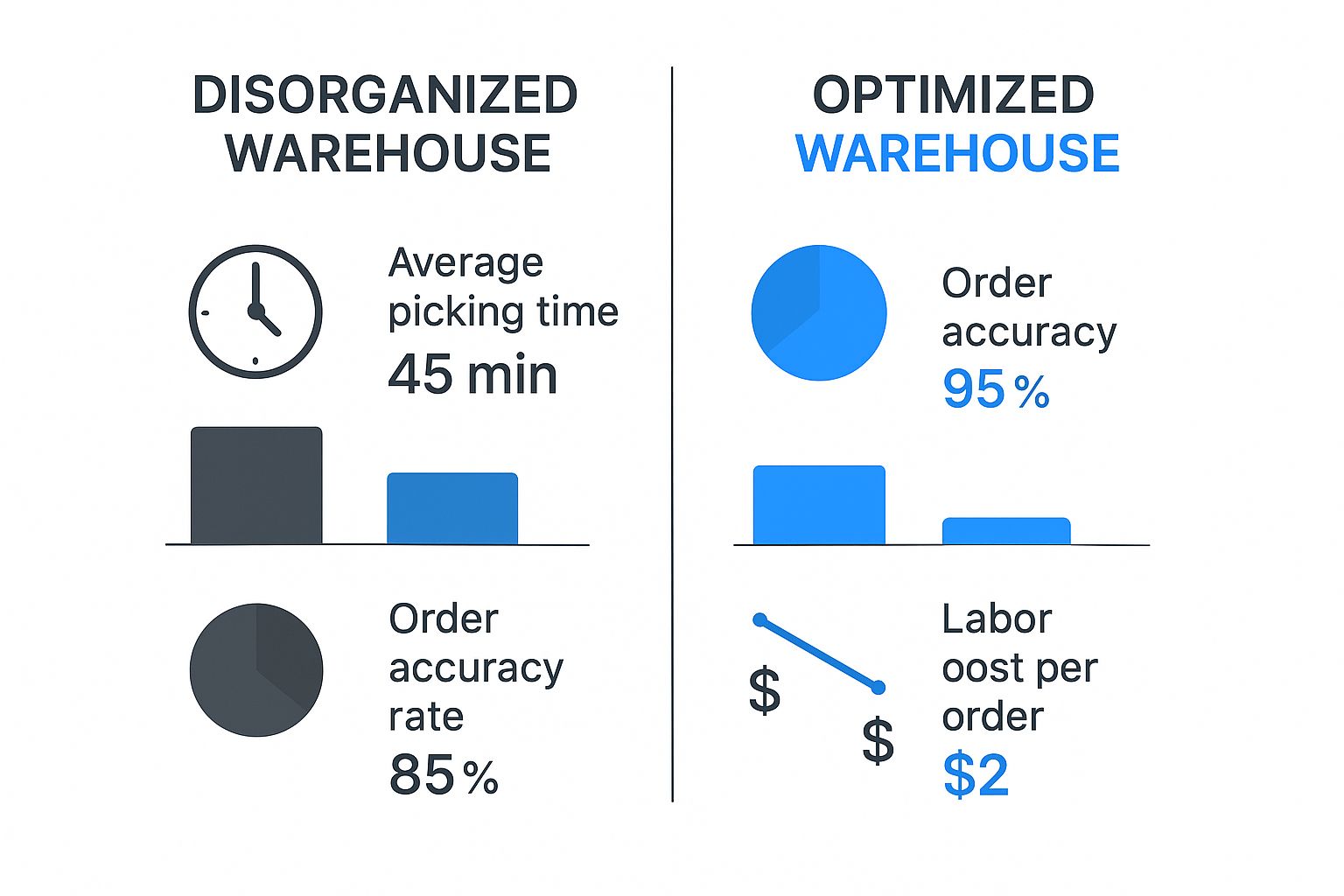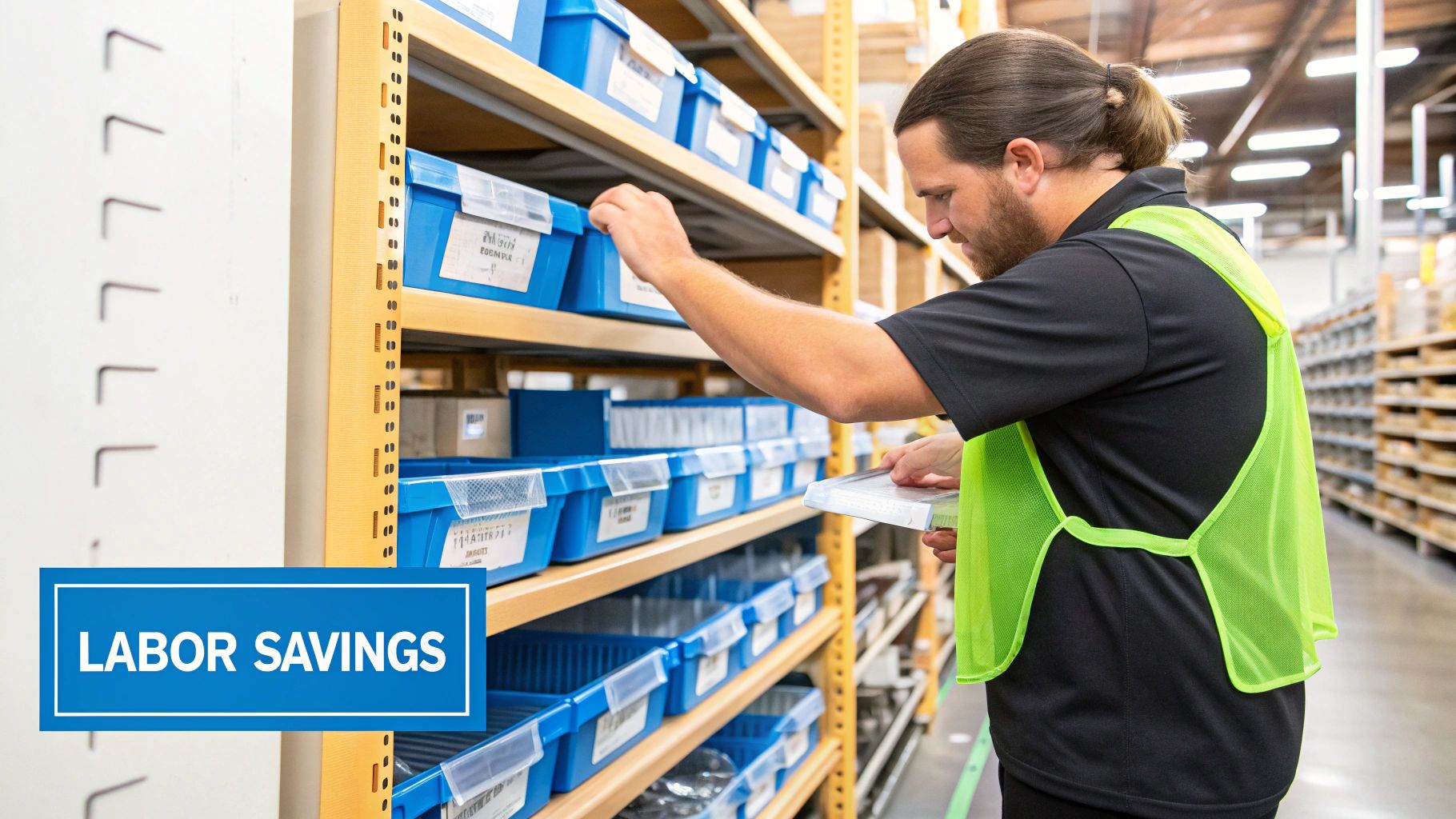Think about your kitchen for a second. The coffee mugs are right next to the coffee maker, your go-to spices are within arm's reach of the stove, and the cutting boards are right by the counter where you do all your prep. That’s the core idea behind warehouse slotting: strategically placing inventory to make finding and picking items as fast and painless as possible.
It’s the deliberate process of organizing a warehouse not just to be tidy, but to be hyper-efficient.
At its heart, warehouse slotting is a system for giving every single product a specific, logical home on the shelf. Instead of just putting new inventory wherever there's an open spot—a common but chaotic practice—slotting uses data to figure out the best possible location for every SKU.
This simple shift, moving from a random approach to a calculated one, can completely change your fulfillment operation. It turns the warehouse from a daily headache into a real competitive advantage.
This practice is generally broken down into two main levels. Macro slotting looks at the big picture of the warehouse layout, like deciding to place your fastest-selling product categories closer to the packing and shipping stations. Then you have micro slotting, which gets granular. This is about the precise positioning of individual products along a picker’s route to cut down on their travel time. A great example is placing your top 20 best-sellers in those easily accessible, waist-high bins that don't require bending or reaching. You can dive deeper into various warehouse layout strategies with this guide from Inbound Logistics.
The difference between a warehouse running on a slotting strategy and one without is truly night and day. A disorganized space creates painfully slow pick times, a constant stream of errors, and exhausted staff who spend most of their day just walking around.
On the flip side, a warehouse optimized with smart slotting runs like a well-oiled machine.
This infographic paints a clear picture of the operational leap forward you can achieve, comparing key metrics in a disorganized space versus one that's been strategically slotted.

As you can see, a well-thought-out slotting plan can do more than just tidy up the shelves—it can slash the average picking time by more than half and push order accuracy to near-perfect levels, which directly lowers your labor costs.
To put it simply, a good slotting strategy is the foundation that supports all of your key performance indicators (KPIs) across your fulfillment operation. The benefits go far beyond just having a cleaner warehouse.
Just look at how it transforms the day-to-day work:
This table shows that slotting isn't just about organization; it's a fundamental operational shift that drives measurable improvements across the board, from saving time and money to making your team's job easier.
Here are a few of the biggest wins:
In the fast-paced world of ecommerce, speed isn't just a benefit—it's the entire game. Customers now expect their orders to show up with almost unbelievable speed, often demanding next-day or even same-day delivery. This pressure has turned the warehouse from a simple storage space into the critical engine powering your customer satisfaction.

This is precisely where understanding what is warehouse slotting becomes so important. Every single second you can shave off the fulfillment process inside your facility translates directly into a faster delivery for your customer. Think of strategic slotting as the bridge that connects a product sitting on a shelf to that happy customer unboxing their package on time.
Today's online shoppers have zero patience for delays or mistakes. A disorganized warehouse, where pickers are left wandering up and down aisles searching for items, is a direct recipe for slow processing times and fulfillment errors. This inefficiency is the root cause of late shipments, wrong orders, and the kind of negative reviews that can seriously tarnish a brand's reputation.
A smart slotting strategy attacks these problems head-on. By placing your hottest-selling items in the most accessible locations, you slash the time it takes to pick, pack, and ship an order. This kind of optimization is fundamental to modern e-commerce operations that want to meet—and beat—customer demands for speed and accuracy.
A well-slotted warehouse doesn't just store products; it anticipates customer demand. It’s designed to fulfill orders at the speed of a click, ensuring the promises made on your website are kept in the real world.
The pressure on fulfillment skyrockets during peak seasons like Black Friday or the holiday rush. During these intense periods, order volume can jump tenfold. A disorganized warehouse will buckle under that kind of strain almost immediately, leading to massive backlogs and waves of customer frustration.
Strategic slotting is how you prepare your operation for these predictable surges. By digging into past sales data, you can pre-position seasonal bestsellers and key promotional items for maximum picking efficiency before the chaos even begins.
This proactive approach keeps your fulfillment process running smoothly, even when order volume is at its absolute peak. You can get a deeper look into the mechanics of this process by exploring how ecommerce fulfillment works from start to finish. Without this preparation, brands are risking stockouts, shipping delays, and a huge loss of revenue during their most important sales periods. An optimized system becomes the foundation for growth and lasting customer loyalty, turning logistical headaches into a true competitive advantage.
Putting a smart slotting strategy in place goes way beyond just making your warehouse look tidy. It translates directly into real, measurable gains for your business. When every single product has a strategic home, the entire fulfillment operation gets faster, cheaper, and far more reliable.
These aren't just theoretical improvements—they show up in black and white on your bottom line.

The positive effects ripple across your entire operation, touching everything from your team's efficiency to your customers' happiness. A well-slotted warehouse is simply a more profitable one, built on a solid foundation of intentional organization.
The single biggest line item in most warehouse budgets is labor. A huge chunk of that cost comes from one simple activity: walking. In a disorganized facility, it’s not uncommon for pickers to spend more than half their shift just traveling between locations.
Smart slotting attacks this wasted time and money head-on.
By placing your fastest-moving products (your "A" items) in the most accessible, golden-zone spots right near the packing stations, you dramatically cut down the steps needed for each order. This might seem like a small tweak, but it adds up to miles of saved walking every single day. That means you can ship the same number of orders with fewer labor hours.
Warehouse space is a premium, and expanding it is even more expensive. Before you even think about signing a lease on a bigger building, a good slotting strategy can help you unlock a surprising amount of hidden capacity right where you are. It’s all about making sure every cubic foot is pulling its weight.
This means matching product sizes to the right-sized storage spots—no more tiny items hogging an entire pallet rack. By optimizing your storage density, you can fit more inventory into the same footprint. The benefits here are huge, with studies showing that effective slotting can significantly improve space utilization, often delaying or even eliminating the need for a costly expansion. You can dig into more data on how slotting impacts space and productivity on Extensiv.com.
Strategic slotting is like playing Tetris with your inventory. The goal is to fit everything perfectly, leaving no wasted space and ensuring the most important pieces are always easy to grab.
Mistakes are expensive. Every time a customer gets the wrong item, you’re on the hook for return shipping, the labor to re-process the order, and the very real risk of losing that customer for good. A poorly slotted warehouse is a breeding ground for these kinds of errors.
When products are organized logically—similar items grouped together, look-alikes separated, and every single SKU given a clear, defined home—the chances of a picker grabbing the wrong thing plummet.
This drives up your accuracy rates, which is one of the most critical warehouse efficiency metrics for keeping customers happy and building trust. To learn more about the key performance indicators that matter, check out our guide to measuring warehouse efficiency metrics. This boost in accuracy directly improves the customer experience, cuts down on negative reviews, and builds the kind of reputation for reliability that brings people back.
Picking the right warehouse slotting strategy isn't about finding some magic formula—it's about building a smart playbook for your specific inventory. Think about how a grocery store puts milk at the back to make you walk past everything else. Your warehouse needs that same kind of intentional, data-driven plan to guide where products live.
There’s simply no one-size-fits-all answer here. The best approach hinges on your product mix, how often things sell, and even the physical shape and size of your items. What works like a charm for a clothing brand could be a total disaster for a company selling heavy auto parts.
One of the most powerful and widely used methods is slotting by product velocity, which you might know as ABC analysis. The concept is beautifully simple: your fastest-moving products get the best real estate in the warehouse.
It’s like creating a priority seating chart for your inventory.
This strategy directly tackles wasted motion, making sure your team spends their time and energy on the products that actually make you money.
Beyond just sales data, the physical nature of your products is a massive factor in where they should live. Slotting by characteristics is all about safety, efficiency, and keeping your products in one piece. This is where you group items based on things like their size, weight, or how fragile they are.
For instance, you'd always store heavy or bulky items on lower shelves or pallet racks. This reduces the risk of injury and makes them far easier to handle with a forklift or pallet jack. Fragile goods, on the other hand, need their own secure spots where they won't get crushed or knocked around during picking.
Grouping items with similar physical traits doesn't just improve safety; it creates a much more logical and intuitive picking flow. It stops a picker from having to grab a huge, heavy box from one end of the warehouse and then trek all the way to the other side for a tiny, lightweight item for the same order.
Finally, you have to decide if your product locations are going to be set in stone or if they'll be more flexible.
The right choice really boils down to your business. A company with a stable, predictable product catalog might do great with a fixed system. But a fast-fashion brand with inventory that changes every season would get a massive boost from going dynamic. The key is to look at your data and pick the strategy that truly supports your operational flow.
Not too long ago, warehouse slotting was a manual affair, guided by spreadsheets, experience, and a healthy dose of guesswork. Today, that’s ancient history. Technology has turned slotting from a static, once-in-a-while task into a dynamic, intelligent process that adjusts on the fly.

This evolution is powered by the Warehouse Management System (WMS), which acts as the operation’s central nervous system. A modern WMS constantly sips data—sales velocity, seasonality, product dimensions—giving you the raw ingredients for much smarter decisions.
The real game-changer, though, is the infusion of artificial intelligence (AI) and machine learning. These systems don’t just look at past data; they analyze it to find hidden patterns and predict future demand with startling accuracy.
For instance, an AI might notice two different SKUs are almost always bought together. Its recommendation? Place them next to each other to slash pick times. Or it might see an upcoming promotion and proactively suggest moving that product to a prime forward-picking location before the sale even starts. This is a level of foresight that’s simply impossible to achieve manually. Executing these strategies effectively relies on powerful warehouse automation software.
This data-first approach lets your warehouse adapt in near real-time, unlocking some incredible efficiency gains. The results speak for themselves.
Some distribution centers have slashed picker travel distances by as much as 65-70% by using analytics to fine-tune their pick paths. Another e-commerce operation cut warehouse congestion by 50% and boosted units picked per hour by 30% just by re-slotting their fastest-moving products. It’s a clear demonstration of data turning into dollars.
Technology turns warehouse slotting from a chore into a competitive weapon. It allows businesses to continuously optimize their layout, ensuring the warehouse is always aligned with current customer demand and operational goals.
Getting to world-class fulfillment efficiency is a marathon, not a sprint. But the good news is, you don’t have to build the entire operation from the ground up. For a growing business, bringing on a third-party logistics (3PL) partner is a smart, powerful way to implement advanced warehouse slotting without the massive upfront investment.
A great 3PL isn't just a vendor; they're a direct extension of your team. They bring their existing technology, optimized infrastructure, and hard-won operational expertise straight to your business, applying sophisticated slotting methods on your behalf from day one. You get immediate access to enterprise-level optimization without buying a WMS, leasing a warehouse, or hiring a specialized logistics team.
Outsourcing your fulfillment means you can scale operations at the flip of a switch. A good 3PL partner already has processes dialed in to handle fluctuating order volumes, from the slow summer months to the chaos of a Black Friday rush. Their teams are pros at dynamically re-slotting inventory to keep up with seasonal trends and promotions, making sure your fulfillment engine never skips a beat.
This kind of partnership is the blueprint for achieving high-level logistics without the sky-high overhead that usually comes with it.
By entrusting slotting to experts, you free up critical resources to focus on what you do best: product development, marketing, and growing your brand. It’s about leveraging a partner's strengths to build your own competitive advantage.
This approach is especially powerful for brands that are expanding quickly or launching in new markets. If you're seeing signs that it might be time to make the switch, you can learn more about when to use a 3PL in our detailed guide. Ultimately, it’s a strategic move that provides the logistical muscle to support your growth ambitions without pulling focus from your core business goals.
Once you start digging into warehouse slotting, a few practical questions always pop up. Getting a handle on these common queries is the key to moving from theory to actually putting a smart slotting strategy to work in your own space.
Let's tackle some of the most frequent questions we hear from business owners.
Think of this less as a one-and-done project and more as a regular tune-up that keeps your warehouse humming. Your business has a rhythm, and your slotting schedule should match it.
A great starting point is a full review quarterly or semi-annually. This cadence is usually enough to catch major shifts in demand before they start costing you time and money. Beyond that, you'll want to re-slot after any big event, like a new product launch, a sudden change in sales trends, or even just updating product dimensions that throw off your current storage plan.
It helps to think of this like building a house. You need both an architect for the overall floor plan and an interior designer for arranging the furniture in each room. Both are crucial, but they operate on totally different scales.
Macro slotting is the architect's view—the big-picture layout of your entire warehouse. This is where you decide where to put your major zones, like receiving, bulk storage, and packing stations, to create a smooth, one-way flow for both your inventory and your team.
Micro slotting is the interior design work. This gets down to the nitty-gritty of deciding the exact shelf and bin for a specific SKU. The goal here is to make the picker's job as easy and efficient as possible, shaving seconds off every single order.
Absolutely. Don't let the term intimidate you—the core idea is simply about reducing wasted motion and making things easier to find. Those principles deliver value whether you're in a 50,000 square-foot warehouse or a 500 square-foot stockroom.
For a small operation, the impact can be immediate. Just moving your five best-selling items right next to the packing station can save hours of labor every single week. It's a simple change that speeds up fulfillment, improves order accuracy, and gets packages out the door faster. Smart organization is a win for everyone, no matter the size.
At Simpl Fulfillment, we live and breathe logistics so you don’t have to. We build expert slotting strategies designed around your unique inventory. Let us handle the optimization so you can focus on growing your brand.